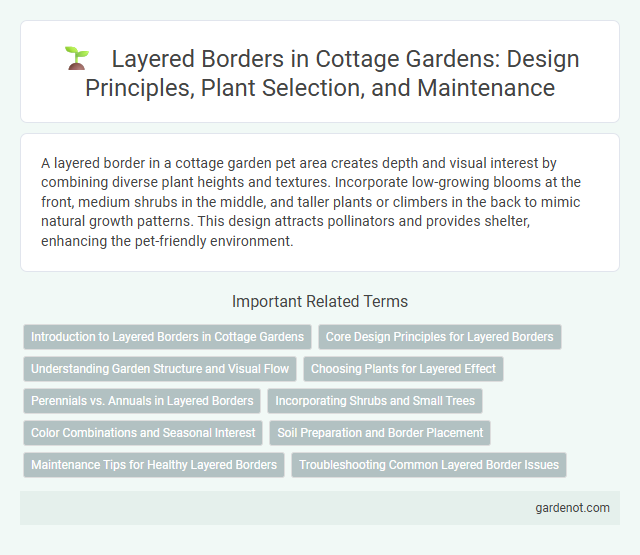A layered border in a cottage garden pet area creates depth and visual interest by combining diverse plant heights and textures. Incorporate low-growing blooms at the front, medium shrubs in the middle, and taller plants or climbers in the back to mimic natural growth patterns. This design attracts pollinators and provides shelter, enhancing the pet-friendly environment.
Introduction to Layered Borders in Cottage Gardens
Layered borders in cottage gardens create depth and visual interest by combining various plant heights, textures, and colors. This planting technique emphasizes a natural, informal look often featuring perennials, shrubs, and climbers arranged in overlapping tiers. Properly designed layered borders enhance biodiversity and provide year-round seasonal appeal.
Core Design Principles for Layered Borders
Layered borders in cottage gardens emphasize plant height variation, color harmony, and seasonal interest to create depth and visual appeal. Core design principles include arranging taller plants at the back, medium-height blooms in the middle, and shorter ground covers at the front to ensure a balanced and lush appearance. Strategic layering supports biodiversity and attracts pollinators, enhancing both the garden's aesthetic and ecological value.
Understanding Garden Structure and Visual Flow
Layered borders in cottage gardens enhance visual flow by strategically arranging plants of varying heights and textures to create depth and interest. Understanding garden structure involves selecting a mix of perennials, shrubs, and climbers that bloom sequentially, ensuring continuous color and movement. This approach not only maximizes space but also guides the eye naturally through the garden, achieving a harmonious and inviting aesthetic.
Choosing Plants for Layered Effect
Selecting plants with varying heights, textures, and bloom times enhances the layered border effect in a cottage garden. Incorporate tall perennials like delphiniums or foxgloves at the back, medium-height shrubs such as lavender or hydrangea in the middle, and low-growing groundcovers like thyme or creeping phlox in the front. This strategic plant placement creates depth, visual interest, and a natural, flowing aesthetic characteristic of cottage gardens.
Perennials vs. Annuals in Layered Borders
Layered borders in cottage gardens combine perennials and annuals to create dynamic, season-long interest and depth. Perennials provide a reliable foundation with recurring blooms and structural form, while annuals introduce vibrant, shifting colors and fill gaps between established plants. Balancing these plant types enhances diversity, supports pollinators, and ensures continuous flowering throughout the growing season.
Incorporating Shrubs and Small Trees
Incorporating shrubs and small trees into a layered border enhances the cottage garden's depth and texture by creating vertical interest and seasonal variety. Selecting species such as hydrangeas, lilacs, or dwarf conifers offers a mix of foliage colors and blooms that support biodiversity and attract pollinators. Strategic placement of these plants ensures continuous flowering and structural framework, promoting a lush, dynamic garden environment.
Color Combinations and Seasonal Interest
Layered borders in cottage gardens create dynamic visual appeal by combining contrasting and complementary color combinations such as soft lavenders with bright yellows and deep greens. Incorporating a mix of perennials, shrubs, and annuals ensures continuous seasonal interest, with blooms transitioning from early spring tulips through summer daisies to autumn chrysanthemums. Strategic layering enhances texture and depth, fostering a vibrant, ever-changing garden that attracts pollinators throughout the growing season.
Soil Preparation and Border Placement
Soil preparation for a layered border in a cottage garden involves enriching the soil with organic compost and ensuring proper drainage to support diverse plant growth. Border placement should follow a tiered arrangement, positioning taller plants like delphiniums and hollyhocks at the back, medium-height blooms such as foxgloves in the middle, and low-growing ground covers like creeping thyme or aubrieta at the front. This strategic layering enhances visual depth, promotes healthy root development, and maintains balanced moisture levels across the garden border.
Maintenance Tips for Healthy Layered Borders
Regular pruning and deadheading promote vigorous growth and prevent overcrowding in layered borders. Applying organic mulch conserves moisture, suppresses weeds, and improves soil health for resilient plants. Monitoring soil pH and fertilizing with balanced nutrients tailored to specific plant needs supports optimal bloom and foliage development.
Troubleshooting Common Layered Border Issues
Troubleshooting common layered border issues in cottage gardens involves addressing plant overcrowding, uneven growth, and poor soil drainage. Ensuring proper plant spacing and selecting compatible species promotes healthier layering and better visual balance. Regular soil amendments and strategic pruning help maintain plant vigor and prevent border decline.
Layered border Infographic

 gardenot.com
gardenot.com